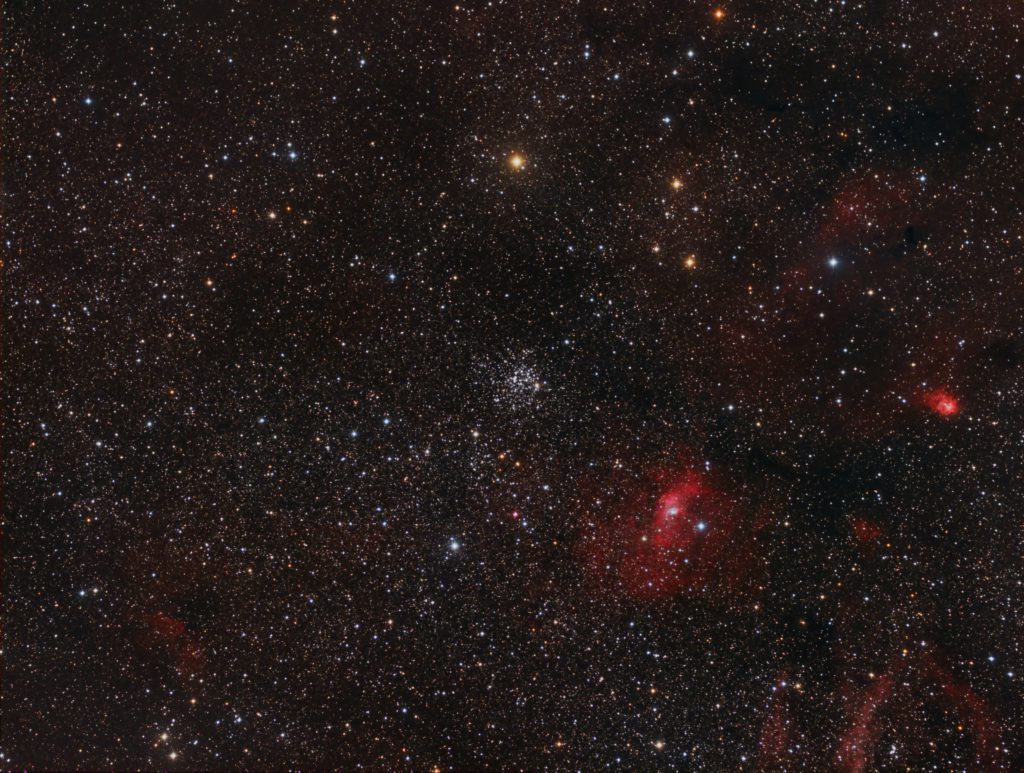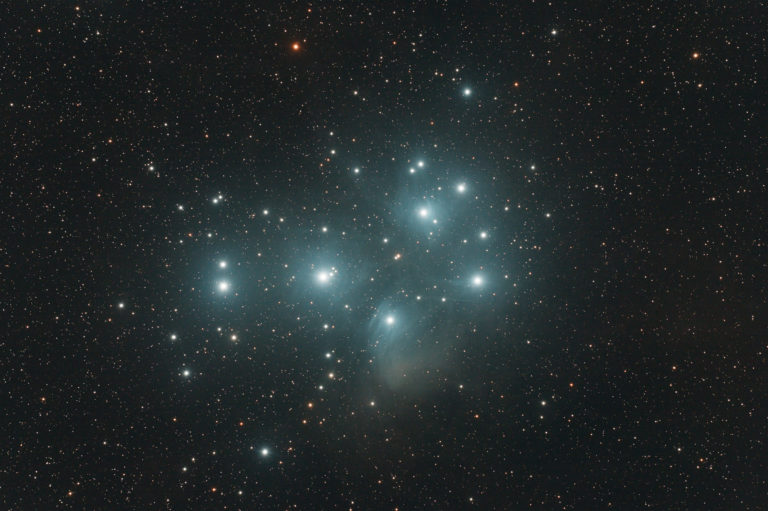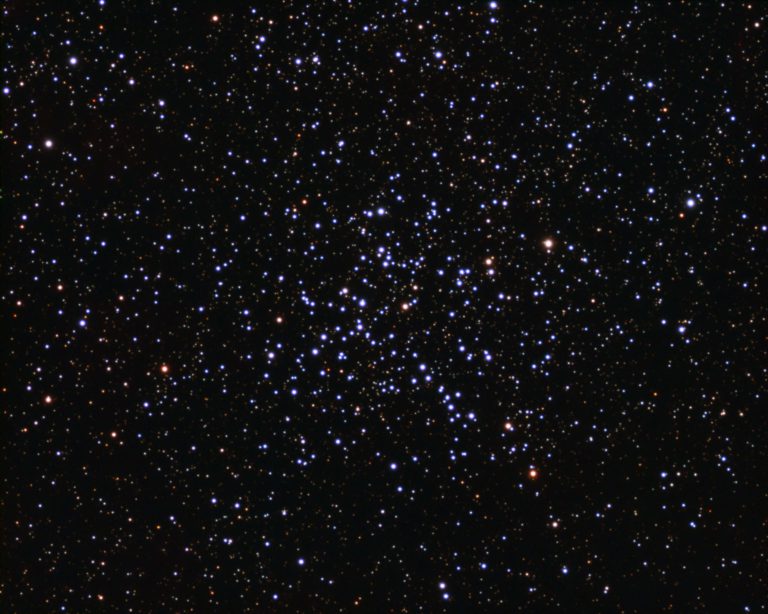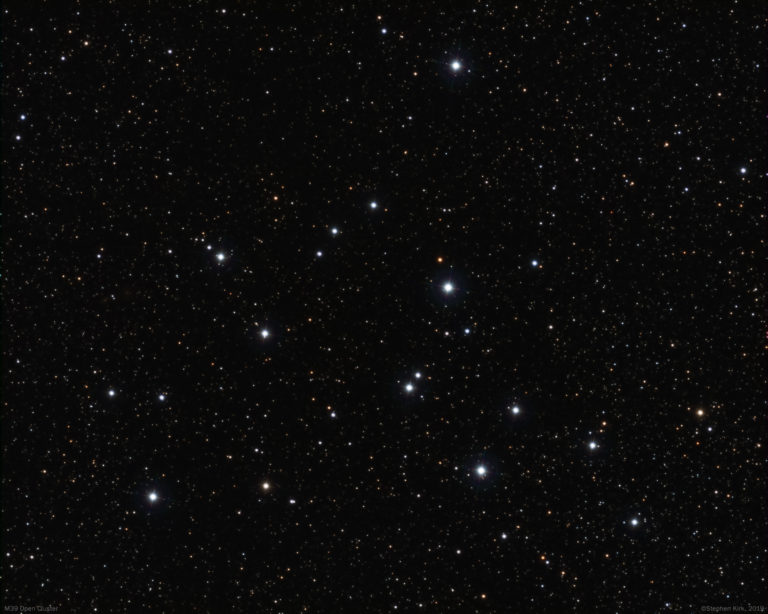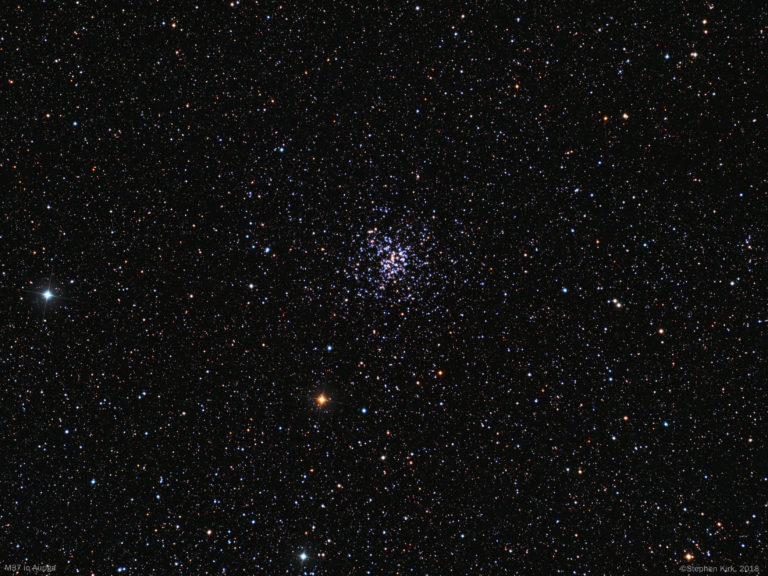M52 is a fabulous open star cluster in Cassiopeia. It is set against a huge amount of nebulosity that spans across the constellations of Cassiopeia and Cepheus. In this image The Bubble Nebula can be seen at the four o’clock position with respect to M52 and many other objects in the Sharpless Catalogue of nebulae are also visible. These are detailed in the annotated version of the image below. The square red box on the finder chart on the right represents the image.Full resolution image here (opens in a new tab). Technical Information Imaged from my backyard in Nottingham, UK on 28 November 2021 with a FSQ85 refractor and a Moravian G2-8300 cooled CCD camera with Astrodon HaRGB filters on my MESU200 mount guided with OAG.All image data is binned 1×1: Note I do not capture a separate luminance when I bin all of the data channels is 1×1 in…
Easily visible with the naked eye, M45, The Pleiades – sometimes referred to as The Seven Sisters, is a well known and famous Open Cluster in the constellation of Taurus. IT has been known since ancient times due to its prominence. The cluster is located between 450-500 light years away and contains several hundreds member stars. The cluster is quite young by astronomy standards and the cluster is moving through a cloud of gas which is easily visible in images and can been seen visually in a dark sky as well. M45 – THe Pleiades Technical Details Imaged from my backyard in Nottingham on Saturday 9th January 2021 when high to The South. A meridian flip occurred half way through the data acquisition. I used my Takahashi FSQ85 refractor and QHY268C One Shot Colour camera. The image was created with quite a small data set of only 38 x 180s…
M38 is the third of three Messier Open Clusters in the constellation of Auriga, in the Northern hemisphere of the sky. The other two Messier clusters are M36 and M37. All of them are easily visible with binoculars and are seen as faint smudges against the darker background. If you read my post on the Constellation of Auriga you will see all three of the Open Clusters in the same image M38 Open Cluster Image Technical Data Imaged from my back yard in Nottingham, UK on the 18th January 2020 whilst high overhead from my location. I used my TEC 140 refractor with Atik 460 cooled CCD camera and Astrodon RGB E Series Generation 2 filters. I used my MESU 200 mount guided with OAG. All exposures binned 1×1: Red > 12 x 180s ; Green > 14 x 180s ; Blue > 13 x 180s. This gives a total integration…
M39 is an open cluster, about 1100 light years distant, in the constellation of Cygnus, The Swan. M39 is about 30 arc minutes in diameter, about the width of the full moon. The Cygnus constellation abounds in interesting objects and The Milky Way galaxy flows straight through it. M39 Open Cluster in Cygnus ImageTechnical Data Imaged from my backyard in Nottingham, UK on the 16th October 2019 when it was high overhead from my location. I used my TEC 140 refractor and Atik 460 cooled CCD camera with Astrodon RGB E Series Generation 2 filters. I used my MESU 200 mount guided with an off-Axis guider. All exposures binned 1×1: Red > 15 x 120s ; Green > 12 x 120s ; Blue > 15 x 120s M39 Annotated M39 Inverted I hope you like it! 🙂
M37 is one of the three Messier Open Clusters in the Constellation of Auriga – the other two being M36 and M38. It is about 4500 light years away and contains several red giant stars, visible in this image, making it the richest of the three Auriga Messier Open Clusters. M37 appears high overhead from my 53 degree norther location during the winter months making it an ideal target for visual observations and imaging. It makes a fine site in a telescope and appears as a fuzzy ball in a pair of binoculars. M37 Image Technical Data Imaged from my backyard in Nottingham, UK on the 9th February 2018. I used my Takahashi FSQ85 refractor and Moravian G2-8300 cooled CCD camera with Astrodon RGB filters. All expsoures are binned 1×1.Red > 12 x 120s ; Green > 12 x 120s ; Blue > 12 x 120s M37 Annotated Version M37…

